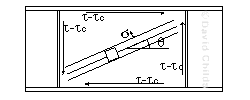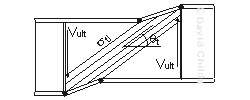
Shear Capacity of Steel Beams to BS 5400
The Code allows beams to be designed to fail at Ultimate Limit State.
Shear failure of a beam, with transverse web stiffeners, develops in three stages :

Stage 1 Initially pure shear is developed within the unbuckled web.

Stage 2 A diagonal tension field is developed when the web has buckled.

Stage 3 Plastic hinges develop in the flanges which produce a mechanism for collapse to occur.
When the web buckles, at the limit of stage 1, the diagonal compressive stress in the web is assumed to be at at its maximum. The diagonal tensile stress is usually far from its maximum at this stage. If transverse web stiffeners are provided then the beam can carry additional load by truss action (stage 2).

The web forms the tie members of the truss (with its spare tensile capacity), whilst the transverse stiffeners form the strut members. The formation of this truss action is referred to in the Code as "tension field action".
The top and bottom flanges act as the top and bottom chords of the truss. Bending of these members is increased as the tension in the web increases. Failure occurs when plastic hinges form in the flanges to produce a mechanism (stage 3).
Figures 11 to 17 in the Code enable the web to be designed to achieve an ultimate capacity utilising this mechaism failure. The term mfw in the graphs represents the plastic moment of resistance of the flanges. If Figure 11 (mfw = 0) is used for design then this will ensure that the plastic hinges are not developed in the flanges.
The design rules for determining the initial web section are :
- From Clause 9.9.2.2
Use Figure 11 (mfw = 0); this ensures that the flanges are prevented from buckling by tension field action. - Use a transverse stiffener spacing to web depth ratio of 1.
- Use a web thickness with reserve capacity.
Contact David Childs

